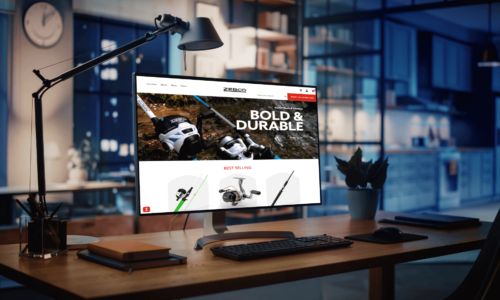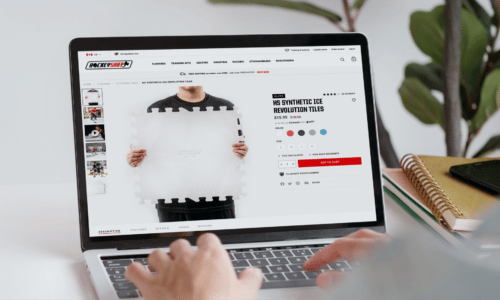C onsidering the average eCommerce store has a conversion rate of less than 5%, retailers and other B2C ecommerce companies need to take a hard look at their website properties in order to capitalize on this phenomenon.
Originally projected for 2024, United States consumers will spend an astounding $1 Trillion in 2022 thanks to the global ecommerce acceleration. BlueBolt can help companies improve their revenue by focusing on key strategies of successful B2C ECommerce websites.
User Focused Personalized Journeys
While personalization has been a buzzword for over five years now, there are many brands who are still struggling to implement personalization. One of the biggest reasons for this is many marketers have a hard time making sense of their data because they don’t have the right reporting tools in place. The best software implementation partners will have Creative Design and Systems Integration teams that will help clients put tools in place like Google Analytics 4 and Optimizely Intelligence Cloud, that deliver actionable insights marketers can use to glean important information and improve their website to drive personalized experiences, win customer loyalty and increase revenue. After all, personalization drives performance and better customer outcomes. It is more and more critical to start applying personalization. When comparing slower-growing and fast growing companies, 40% or more of the revenue from the faster growing companies is being delivered by personalization.

Appealing Branding Throughout the Website
Partnering with a full service software implementation partner that specializes in data driven website design is vital when implementing your website. Often marketers think that printed marketing materials easily correlates to digital assets. However, UX strategy masters take into account where digital assets are being used in regards to user workflows. Most often, wireframes are detailed out incorporating where it’s best to use each asset to enhance the final customer experience. Today, 75% of people form their opinion about a website based on website aesthetics.
Ease of Navigation
We have all found ourselves on websites with poor navigation that are essentially frustrating rabbit trails of trying to find content and products. Thankfully with the combination of mega navigation menus and federated site search, customers can now find desired items quickly and easily. When looking at a website for the first time, 38% of consumers look at a website’s search or navigational links. Great B2C sites not only offer the products customers are looking for, but they also offer engaging and helpful content in hope to best serve their customer and turn them into a repeat buyer.

Modern Site Search Functionality
For ecommerce sites, a robust and intuitive site search is critical to both ROI and customer loyalty. 43% of users on retail websites go directly to the search bar. Consumers who use search are 2.4 times more likely to buy. Searchers also drive more revenue, spending 2.6x more across mobile and desktop compared to those who don’t use search. In an age where customers want content and products served up quickly, offering site search is the key to pleasing customers. However, many companies or brands have multiple websites. Enter Federated Site Search by BravoSquared. Now marketing teams can serve up site search across all website properties, even disparate sites on multiple software platforms, delivering content and commerce like never before.
Mobile First
Is your team making a mobile first website a top priority? Because 91.5% of people in the world own a smartphone, it’s tablestakes for marketers to ensure their website is optimized for mobile users for both content and ecommerce. Ensuring customers can quickly find their products and experience a frictionless checkout experience on their smartphone is critical to driving revenue. After all, 74% of visitors are likely to come back to a site if it has good mobile UX.

Smart Product Recommendations
In retail stores, merchants have long been positioning like products together such as chips and salsa. Thankfully, Smart Product Recommendation Engines are starting to make this more common in ecommerce. Categories such as display products based on browsing history, frequently bought together items or related items help customers impulse shop, spending more than they had originally intended to when logging onto your site. 54% of retailers reported product recommendations as the key driver of the average order value in the customer purchase. With the ever-increasing costs of customer acquisition, it’s important to not overlook smart product recommendations.
Embracing All Sales Channels
The world of ecommerce is becoming more and more fragmented with the emergence of different channels in which selling takes place. A great article from our ecommerce partner, Shopify, shares how embracing the new multitude of sales channels can pay dividends for clients. Gone are the days that a simple ecommerce store is the only way to reach your audience members. Today sellers have access to traditional marketplaces, modern marketplaces (including virtual worlds with NFTs), retail stores, wholesale channels, resellers, white label, mobile apps, direct to consumer, B2B sales, partnerships and more. While this can be overwhelming at times, the opportunities ecommerce companies have to market their products are more abundant than at any other time in history.

Friction Free Checkout Process
In an industry with 70% cart abandonment, providing a friction free checkout process is essential. However, to protect you as a merchant, your checkout also needs to be PCI compliant and secure. Currently 1/3 of all ecommerce business is using Shopify’s Shop Pay app, which boasts a 4x faster checkout and converts at a 1.91x times higher than regular checkouts. The other great thing about the Shop Pay app is that it allows merchants to configure it to the settings they like, while keeping up the guardrails that make it PCI compliant, protecting the merchant. Brands have their work cut out for them when competing with frictionless checkout processes like Shopify and Amazon offer.
Systems Integrations
Systems integrations is what makes the business world live in harmony. Things that were once handled manually now “have an app for that.” Whether it’s sales data, business data, inventory management or selling via online marketplaces, systems can now be designed interconnectedly to help your business automate the important – and run smoothly. This enables teams to streamline their efforts and become more effective at running the business, making it easier to achieve your KPIs and increase your ROI.

Social Proof
Historically a LuLuLemon marketing strategy, the past three years has seen the popularity of User Generated Content (UGC), and brands paying influencers to advertise their product, absolutely explode. Recent studies indicate that there is a 106.3% lift in conversion among visitors who interact with user-generated imagery on a product page. Staying on par with this trend, Shopify recently released Dovetail, a product helping brands interact with their influencers and handle their affiliate marketing seamlessly.
Your Secret Sauce Online
Every great brand has a personality or a cause that pulls their followers in. When asking our team which brands they liked, the answers ranged from Athleta to Goli to Southwest Airlines, all of which have a clear brand voice that has been translated to their website. 94% of customers are likely to show loyalty to a brand that offers complete transparency. When asked why our team liked these brands, it was clear that these companies have a seamless experience between their website, their influencers and their brands. We heard that Althleta clothing is comfortable for an athlete while being high quality and size inclusive. Goli Vitamins are not only good for you, but have a mission to do good in the world. Finally, Southwest Airlines employees are a great brand ambassadors for the “Luv Airline.”

Search Engine Optimization
In a time where customer acquisition ads are quickly becoming cost prohibitive, Search Engine Optimization becomes extremely important so that brands can be found by customers without spending a fortune on Google Ads. The daunting stat that 75% of people never scroll past the first page of search engines have marketers doubling down on ensuring they are fine tuning their SEO strategies. With 63% of all shopping beginning online, even if the purchase itself happens in a store, it is imperative that retailers who do not understand SEO strategies work with partners like BlueBolt to help them get a competitive advantage in today’s marketplace.
Page Speed and Conversion Rates
According to a 2019 study by Portent, a 0-4 second load time is best for conversion rates, and the first five seconds of page-load time have the highest impact on conversion rates. Matter of fact, the best ecommerce conversion rates occur on pages with load times below 2 seconds. Each additional second of load time, drops website conversion rates by an average of 4.42%, the study says. Online tools like Google Page Speed Insights allow you to time and test your website’s page speed. You can also cache your website or enable browser caching to speed up your page load time.
Conversion Rate Optimization
In 2022, one of the most lucrative strategies marketers can employ is conversion rate optimization. Surveying over 3,000 CRO tool users, a VentureBeat study revealed that the average ROI of using CRO tools is 223%. Further, only five percent survey respondents did not generate ROI, meanwhile 173 high performing marketers said they gain returns higher than 1,000 percent! Fortunately, partners like BlueBolt can come alongside marketing teams to help implement CRO testing and harness the data to make it actionable. Platforms like Optimizely’s Intelligence Cloud can also help brands instill a sophisticated experimentation platform to help jumpstart an environment that thrives on optimization.

WCAG and Americans with Disabilities Act (ADA) Compliance
The Baymard Institute reports that 94% of the largest eCommerce websites fail to meet the Level AA requirements of the Web Content Accessibility Guidelines (WCAG) 2.1, the standard for digital accessibility. The most common accessibility problems include:
- Not providing text alternatives for images and other non-text content
- Missing link text descriptions
- Keyboard navigation issues
- Inadequate form field markup
For people with disabilities who are trying to shop online, these issues are not only quite frustrating, but often a deal breaker. Thankfully, most of the problems could be addressed easily and inexpensively. Over one billion people live with a disability, making compliance a key to unlocking additional revenue and stronger brand loyalty. As the global population continues to age, digital accessibility will need to become a key consideration for retailers.
In summary, a ton of careful planning, organization and execution goes into making a high performing B2C ecommerce site. Whether you are a retailer or other B2C company, BlueBolt is here to help answer questions and deliver on your priorities. Since 2005, we have helped hundreds of companies with both B2C and B2B ecommerce implementations, integrating content management systems, developing federated enterprise site search solutions and helping set up cultures of optimization and experimentation – all of which help our customers improve their ROI for their digital projects.



